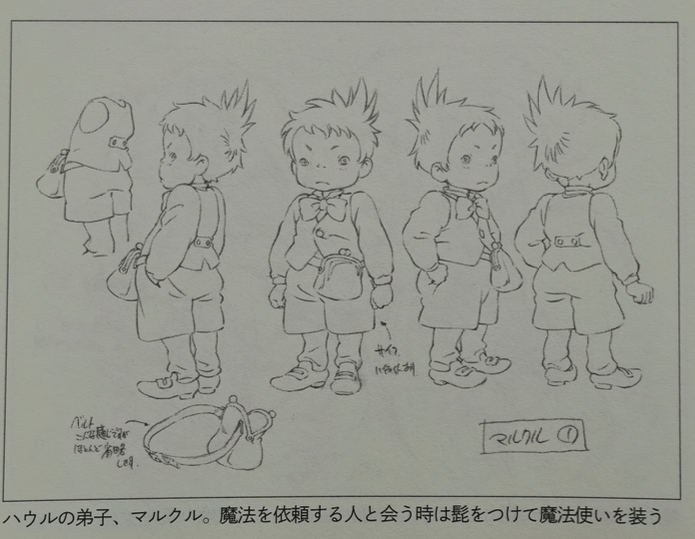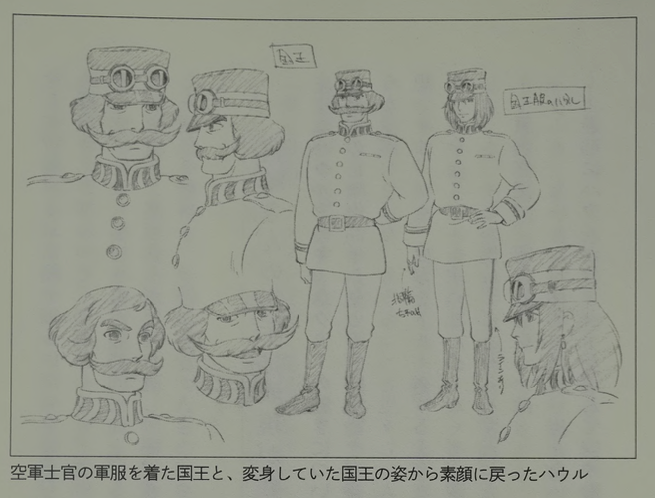Yamashita Akihiko (Animation Director)
Interviewer: How was the work on “Howl”?
It was a stimulating day-to-day and fulfilling. I’m happy to be able to work with a director who has such an intense personality. You can see his view of life. For example, changing the original work significantly and turning the Witch of the Waste into a good person, I think most directors would depict her as a bad person. It felt like a lot of thought was put in to portray her in that way.
Interviewer: Your involvement with the work must have changed a lot, having participated not as a key animator this time but as an animation director, right?
It changed. When I do key animation, I can draw as I like and it ends there, but this time I am on the cooking side. There are times when key frames that are completely different from what the director had imagined come up, but in Mr. Miyazaki’s case, if the scene expands with it, he would use it. I think it will be useful for my future work to be able to see the selection of what is good and what is not good being next to the director.
Interviewer: What kind of conversation did you have with Director Miyazaki?
There was a lot of small talk while working. There were also conversations about the content, but I’ve somewhat forgotten them. Rather, I remember what was said after completion. There were many critiques of this movie like “It has the ‘flair’ of Yamashita” or “The goodness of Yamashita’s character comes to the fore.” I don’t know whether that’s a good or bad thing (laughs).
Interviewer: How was it having three animation directors?
I could see the strengths of each, and I enjoyed it. I’m glad I could see the delicacy of Mr. Inamura and the dynamism of Mr. Kousaka.
Interviewer: Mr. Yamashita, where did you work on the animation directing?
Almost the whole story. In the early days of production, Mr. Miyazaki’s quite detailed rough sketches came in conveying, “Make the acting like this and that,” and I was mainly working on turning them into key frames. Then, Mr. Inamura would revise the faces and small parts to complete them. From the middle, Mr. Kousaka joined and I asked him to mainly revise the key frames of difficult scenes. And then Mr. Inamura would finish it off. That’s the basic flow. I revised the acting, Mr. Kousaka revised the key animation, and Mr. Inamura revised the characters to finish them.






Mr. Miyazaki’s Directions are Attractively Expressed
Interviewer: What impression do you have about the movements of the characters in “Howl”?
I think the past Miyazaki works had a lot of cartoon-like movements, but this time it was different. I felt they pursued more life-like human movements and depicted them. But it’s not tracing live-action, it’s still expressionistic, like a cartoon. It’s not seeking complete realism, but rather “cartoonizing” based on reality. That was very easy for me to do and interesting.
Interviewer: In the key animation revisions, were there any memorable scenes?
Hmm, I can’t quite remember anything specific…
Interviewer: How about the scene where Howl first takes Sophie for a walk in the sky?
In that scene, I particularly revised Howl. Mr. Miyazaki said, “Howl’s clothes are not fluttering in the wind. The sleeves and hem are like the wings of an airplane, keeping balance.” Initially, the clothes were fluttering normally, but I revised them to make them seem as if they were catching the wind lightly. The directions were unique, appealing and of course accurate. During “Spirited Away,” I worked on the scene of Chihiro and Haku’s free fall, and even then he said, “It’s not a real free fall. It’s like a wind that gently wraps around the two.” I thought it was a great way to put it.
Interviewer: Sophie changes her appearance frequently from eighteen to ninety years old, and of course, her movements change with it.
At first, I thought Sophie was just a girl who was turned into an old woman by magic. But it’s not like that. It’s Sophie as really an old woman.
Interviewer: Her attitude and personality also changed to match her age.
She can’t move her body as she wants, and she doesn’t get upset by things, she’s properly an old woman. I misunderstood that at first, it would be a mistake to draw her as if she’s thinking, “I’m a young woman. Even though I’m a young woman, why did I become like this?”
Interviewer: By becoming an old woman, she was liberated from the complex that she had about herself.
Yes. I think that’s the kind of movie it is. In this film, not only Sophie but also Howl and the Witch of the Waste, the key characters change, making the story very dramatic. I think “Howl” is the real masterpiece of Mr. Miyazaki, the drama creation is splendid, and the way the scenes develop is exquisite.
Akihiko Yamashita | Born in Okayama Prefecture in 1966. After working on numerous productions, including character design, storyboard, and animation director for “Giant Robo: The Day the Earth Stood Still,” he moved to Studio Ghibli. He has served as animation director for “Howl’s Moving Castle,” “Arrietty,” and “From Up on Poppy Hill,” as well as storyboard and animation direction for “Tales from Earthsea,” assistant animation director for “When Marnie Was There,” and key animation for “The Wind Rises,” playing important roles in almost all works.